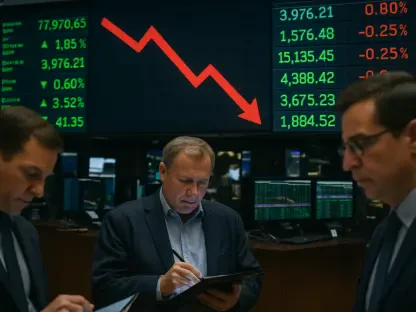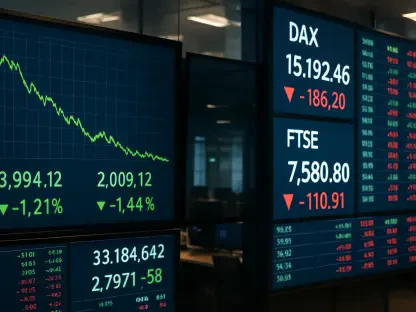Today, we’re thrilled to sit down with Priya Jaiswal, a renowned expert in banking, business, and finance, whose sharp insights into market analysis and international trends have guided investors through turbulent times. With Wall Street experiencing a rollercoaster of a session recently and tech giant Nvidia making headlines with its stellar performance, we dive into the forces shaping the U.S. stock market. Our conversation explores the ups and downs of major indexes, Nvidia’s pivotal role in the AI boom, the ripple effects on other tech stocks, and the broader economic concerns tied to Federal Reserve policies and upcoming labor data.
How would you describe the overall mood on Wall Street during Wednesday’s trading session, and what stood out to you about the performance of the major indexes?
Wednesday was a bit of a wild ride on Wall Street, but ultimately, the markets closed on a positive note. The Dow Jones Industrial Average crept up by 0.1%, ending at 46,138.77, while the S&P 500 gained a solid 0.4%, closing at 6,642.16. The Nasdaq Composite led the pack with a 0.6% increase, finishing at 22,564.23. What stood out was the choppiness—there were moments where gains slipped, particularly after the Fed minutes were released, hinting at caution over inflation. But tech stocks, especially ahead of Nvidia’s results, really helped push the indexes higher and recover from recent losses.
Speaking of Nvidia, their after-hours performance grabbed a lot of attention. Can you break down what happened and what fueled that surge?
Absolutely, Nvidia was the star of the show. After closing the regular session up 2.8%, their shares jumped over 5% after hours. The big driver was their fourth-quarter revenue forecast, which came in above Wall Street’s expectations. This signaled strong confidence in sustained demand, particularly in the AI space, and investors reacted with enthusiasm. It’s a clear sign that Nvidia continues to capitalize on the tech trends shaping the future.
Nvidia’s role in the AI sector seems to be a game-changer. Why do you think their earnings are viewed as a litmus test for the broader market rally?
Nvidia has become a bellwether for the AI-driven market surge we’ve seen this year. Their chips power much of the infrastructure behind artificial intelligence, and with companies pouring billions into AI development, Nvidia’s growth reflects the health of that investment trend. Their earnings aren’t just about one company—they signal whether the hype around AI can translate into real, sustainable profits. Investors watch closely because if Nvidia stumbles, it could cast doubt on the entire tech rally that’s propelled markets to record highs in 2023.
We also saw movement in other tech stocks after Nvidia’s news. How do you interpret the ripple effects on companies like Advanced Micro Devices and Alphabet?
Nvidia’s success definitely created a halo effect. After hours, Advanced Micro Devices saw a 2.8% bump, Alphabet rose 1.6%, and Palantir Technologies climbed 4%. I think it’s a mix of direct and indirect influence—Nvidia’s strong AI demand reassures investors that the tech sector, especially areas tied to AI and data processing, has legs. But there are also unique drivers for each company, like Alphabet’s cloud computing push or Palantir’s government contracts. Still, Nvidia’s results give the sector a psychological boost, reinforcing optimism.
Shifting gears to economic policy, the Federal Reserve minutes seemed to rattle some nerves. What was it about their stance that impacted the market mid-session?
The Fed minutes revealed a cautious tone that spooked some investors. Policymakers suggested that cutting borrowing costs too quickly could jeopardize their fight against inflation, even after recent rate reductions in September and October. This caused a brief pullback in gains during the session as traders worried about tighter monetary policy lingering longer than hoped. It’s a reminder that while the market loves low rates, the Fed is still walking a tightrope to balance growth and price stability.
With the upcoming U.S. jobs report on everyone’s radar, how do you see it influencing market sentiment in the short term?
The September jobs report, due out soon, is a big deal because it’ll give us a clearer picture of whether the labor market is cooling as much as some fear. Expectations are mixed—there’s concern about weaker hiring numbers, especially after the government shutdown delayed data releases. With October’s employment figures being bundled with November’s, there’s added uncertainty. If the report shows significant weakness, it could fuel recession worries and drag on stocks. On the flip side, a strong report might ease fears and bolster confidence, though it could also stoke inflation concerns for the Fed.
Looking ahead, what is your forecast for how these converging factors—tech momentum, Fed policy, and labor data—might shape the market in the coming weeks?
I think we’re in for a period of heightened volatility. Tech momentum, led by players like Nvidia, will likely continue to drive gains if AI demand holds up, but it’s not a free pass—any sign of overvaluation or profit-taking could trigger pullbacks. The Fed’s stance on rates remains a wildcard; if they signal more caution, expect pressure on growth stocks. And the labor data could be the deciding factor—if it points to a softening economy, we might see a shift toward defensive sectors. My forecast is cautiously optimistic, but investors should brace for bumps and keep a close eye on these interconnected dynamics.









